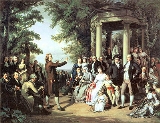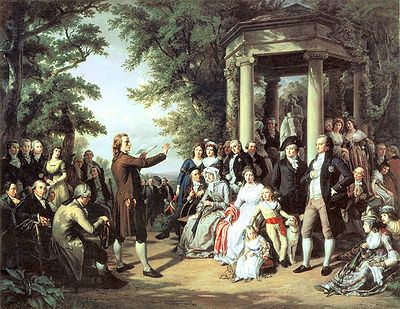
Weimar Princely Free Zeichenschule
Encyclopedia

Friedrich Justin Bertuch
Friedrich Johann Justin Bertuch was a German publisher and patron of the arts. He co-founded the Fürstliche freie Zeichenschule Weimar with the painter Georg Melchior Kraus in 1776. He was the father of the writer and journalist Karl Bertuch.-Early life:Bertuch came from a family attested in the...
(1747-1822) and the painter Georg Melchior Kraus
Georg Melchior Kraus
Georg Melchior Kraus was a German painter. A student of Johann Heinrich Tischbein, he was also a teacher himself , as well as an entrepreneur and friend of Goethe...
(1737-1806), as part of Weimar Classicism
Weimar Classicism
Weimar Classicism is a cultural and literary movement of Europe. Followers attempted to establish a new humanism by synthesizing Romantic, classical and Enlightenment ideas...
. It was financed by the young Charles Augustus, Grand Duke of Saxe-Weimar-Eisenach and heavily promoted by Goethe, who also taught there. Among its pupils were Charles Augustus's future mistress Karoline Jagemann
Karoline Jagemann
Karoline Jagemann von Heygendorff was a major German tragic actress and singer. Her great roles included Elisabeth in Mary Stuart and Beatrice in The Bride of Messina...
. It lasted until 1930.
As Weimar's Geheimer Rat had oversight over the school from 1788 to 1832, it is not to be confused with the Großherzoglich-Sächsischen Kunstschule Weimar (set up in 1860), the original version of the Weimarer Kunsthochschule. The school's classrooms were originally housed in the Roten Schloss, moving into the Fürstenhaus in 1807 and later moving partly to the Esplanade and partly to the Großen Jägerhaus. From 1824/25, under the oversight of custodian and painter Louise Seidler
Louise Seidler
Louise Seidler was a German painter at the court of the grand dukes of Weimar, custodian of their art collection and a trusted friend of the poet Goethe and the painter Georg Friedrich Kersting.-Early life:...
(1786-1866), it also housed the grand-ducal art collection.
Aims
The foundation of the school is a clear indication of the rising interest in arts and crafts in court circles in the second half of 18th century. Its immediate main aim was to instruct local craftsmen in drawing, to sharpen their sense of aestheticsAesthetics
Aesthetics is a branch of philosophy dealing with the nature of beauty, art, and taste, and with the creation and appreciation of beauty. It is more scientifically defined as the study of sensory or sensori-emotional values, sometimes called judgments of sentiment and taste...
in consumables and in the longer term to an increase in the quality of production in handcrafts. In order to advance art, taste and a sense of beauty to as wide a public as possible, its classes and living conditions were open to all classes and both sexes. It was an important place for the discovery and promotion of new talent and drew many artists into the orbit of Weimar Classicism
Weimar Classicism
Weimar Classicism is a cultural and literary movement of Europe. Followers attempted to establish a new humanism by synthesizing Romantic, classical and Enlightenment ideas...
and its "Musenhof
Schloss Tiefurt
Tiefurt House is a small stately home on the Ilm in the Tiefurt quarter of Weimar, about 4km east of the city centre. It was the summer residence of duchess Anna Amalia of Brunswick-Wolfenbüttel.- History :...
".
To complete its pupils' knowledge and artistic talents by comparison and copying, from 1809 the school also developed its own collection of major paintings, giving exhibitions from 1809, which were generally housed from 1824/25 in the Grossen Jägerhaus. From 1837 the dissolved grand-ducal art collection was also put at the school's disposal.
The school's first annual exhibition, for the pupils to display their work publicly, was in 1779. The prize related to the exhibition was traditionally awarded on 3 September, the birthday of Charles Augustus.
The school found a competitor in 1860 with the foundation of the Grossherzogliche Kunstschule, and from then until its dissolution in 1930 the school gave preparatory lessons for students entering the Kunstschule.
Directors
- 1776-1806: Georg Melchior KrausGeorg Melchior KrausGeorg Melchior Kraus was a German painter. A student of Johann Heinrich Tischbein, he was also a teacher himself , as well as an entrepreneur and friend of Goethe...
(1737-1806), painter and etcher, see above - 1807-1832: Johann Heinrich MeyerJohann Heinrich MeyerJohann Heinrich Meyer was a Swiss painter and art writer active in Weimar. A pupil of Henry Fuseli, he went to Rome in 1784, and befriended Goethe in 1787, becoming his right-hand-man in artistic matters...
(1760-1832), painter and artwriter, friend of Goethe, Lecturer from 1795 ? - 1833-1843?: Ludwig von Schorn (?), Art Lecturer, Custodian of the Grand-Ducal Art Collection
- 1843-????: Adolf Schöll (1805-1882), archaeologist, librarian and historian of literature
- 1861-1868: Johann Christian Schuchardt (1799-1870), copper engraver, former private secretary of Goethe .
- 1868-????: Friedrich Preller d. Ä.Friedrich Preller the ElderFriedrich Preller the Elder was a German landscape painter and etcher. From 1832 he was a professor at the Fürstlichen freien Zeichenschule in Weimar. He was the father of the artist Friedrich Preller the Younger.-Life:He was born at Eisenach...
(1804-1878), former pupil, painter and etcher, lecturer from 1843 - 1873-????: Sixt Armin Thon (1817-1901), former pupil, painter, etcher and lithographer, 1873 interim director
- 1896: Hugo Flintzer (1862-1917), painter (Max Thedy's pupil)
- 1917: Franz Goepfart († 1926), painter (Max Thedy's pupil)
- 1926: Arno Metzeroth, painter (Künstlerkolonie Schwaan)
Teachers
Besides the directors, these figures also taught at the school:- 1776: Martin Klauer, sculptor
- 1776: Konrad Horny, sculptor
- from 1820: Ferdinand JagemannFerdinand Jagemann-Life:As son of the librarian Christian Joseph Jagemann, he was brother to the actress Karoline Jagemann. Karoline was mistress to Charles Augustus, Grand Duke of Saxe-Weimar-Eisenach, who allowed Ferdinand to train with the Tischbein painters. He was also a student of the court-painter Georg...
(1780-1820), painter
Pupils
Sorted by class, its pupils included:- Caroline JagemannKaroline JagemannKaroline Jagemann von Heygendorff was a major German tragic actress and singer. Her great roles included Elisabeth in Mary Stuart and Beatrice in The Bride of Messina...
(1735-1804), singer and actor - Johann Wolfgang von Goethe (1749-1832) and his grandson Wolfgang
- Charlotte von SteinCharlotte von SteinCharlotta Ernestina Bernadina von Stein was a lady-in-waiting at the court in Weimar and a close friend to both Friedrich Schiller and Johann Wolfgang von Goethe, whose work and life were strongly influenced by her.-Childhood:Charlotte′s parents were Hofmarschall Johann Wilhelm Christian von...
(1742-1827), courtier, friend of Goethe - Corona SchröterCorona SchröterCorona Elisabeth Wilhelmine Schröter was a German musician best known as a singer. She also composed songs, setting works by Friedrich Schiller to music.-Early life:...
(1751-1802), singer and actor, central figure in Goethe's Liebhabertheater - Fritz von Stein (1772-1844), son of the Frau von Stein, Goethe's schützling
- Julie von Egloffstein (1792-1869), courtier, later a painter
- Franz Horny (1798-1824), later a painter
- Friedrich Preller der Ältere (1804-1878), later painter, teacher and director of the school (see above)
- Franziska Schultze (1805-1859), later a flower painter
- Angelica Facius (1806-1887), later a flower painter and medal-designer
- Ferdinand Konrad Bellermann (1814-1889), later landscape painter
- Friedrich August Mardersteig (1814-1899), later a painter
- Sixt Armin Thon (1817-1901), later painter and interim director of the school (see above)
- Carl Hummel (1821-1907), later a painter
- Karl Hagemeister (1848-1933), later a painter
- Magda Langenstraß-Uhlig, later Absolventin of the Großherzoglich-Sächsischen Kunstschule
- Marianne BrandtMarianne BrandtMarianne Brandt , German painter, sculptor, photographer and designer who studied at the Bauhaus school and became head of the metal workshop in 1928. Today, Brandt's designs for household objects such as lamps, ashtrays and teapots are considered the harbinger of modern industrial...
(1893-1983), later painter, sculptor and designer - Adolph Straube, later sculptor
- Carl Hüttner, later court stucco artist

